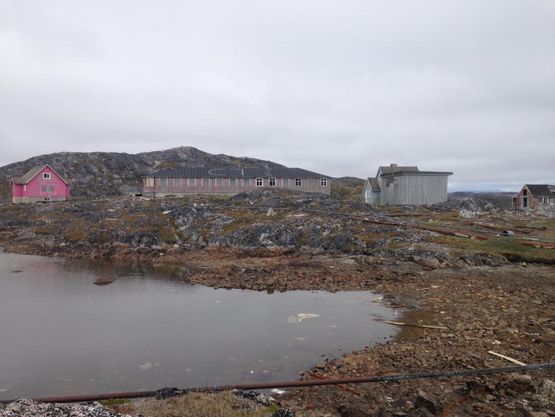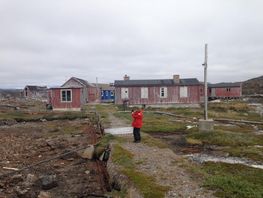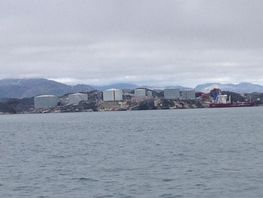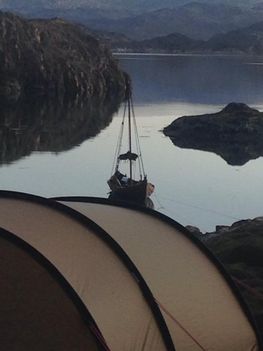“It’s like being at a tank station on the German autobahn”, says Ingeborg. Skjoldungen has now been lying at the ‘Polar Oils’ facility, 37 sea miles south of Nuuk, for three days. The facility is normally home to three people: Olaf, the cook and an assistant. Now, the population has more than tripled to 11, but this hasn’t fazed the locals. They’re used to having visitors. Both large tankers and small fibreglass boats visit to fill their tanks on their way along Greenland’s coast. The residents are, however, ever so slightly impressed by the ‘almost royal’ visit from a Danish Viking ship, and the crew have been well taken care of. “We’re the eight strangers in the back garden, who creep in to use the toilet and wash up in the kitchen. You only come all the way in when invited, so that we don’t overwhelm each other – it’s clear that they’re used to having peace and quiet”, tells Ingeborg, with a smile in her voice.
A trip to the past
Yesterday, Olaf took the crew on a trip to both the old and the new Færingehavn, both of which lie on the northern side of the little fjord.
Færingehavn was established in 1927 as a fishing port for Faroese fishermen. After its establishment, it quickly grew to be an international fishing port, which in its heyday had up to 4,000 residents – as a comparison, Nuuk has 15,000 residents today. The town had both freezing facilities, where prawns could be frozen for export and a large salt silo for the salting of cod. A lighthouse, repair yard, oil tank, salt stores, hospital, seamens’ home and a 230m long landing bridge were built. All of this is now in a serious state of decay.
“It was an amazing experience, visiting the two abandoned towns. They were like some deserted, western town, which had just shut down overnight. Olaf showed us around and it was so exciting to hear his stories. He had actually visited the town as a 15 year old ship’s boy and it was here that he had his first visit to a restaurant at the seamens’ home’s restaurant and bought his very first camera”, recounts Ingeborg. “The quayside and houses are totally falling apart but you can still visit the recreational area, including the cinema, where the film equipment is still standing in position. There are psalm books in the church, kitchen gear in the restaurant’s kitchen. It was like stepping into a time warp and being sent back in time”, tells Ingeborg.
Activities ceased at Færingehavn in 1990 and now the three ‘Polar Oil’ employees at the oil harbour on the other side of the fjord are the only inhabitants in the area.
Towards Nuuk
The crew are keeping an eye on the weather forecast, which has promised a southerly wind of around 7m/s from Thursday morning, local time. If the forecast holds, Skjoldungen will be in Nuuk ca. 10 hours later, possibly around midnight Thursday. “We’re preparing the ship today and sit ready to sail when the wind is right. Right now, there’s too much wind, but the forecast looks like it should be calmer tomorrow morning”.
So Wednesday will be used to prepare the ship for sailing. “We’ve eaten a lot of our provisions and drunk a lot of water, so the weight that we’ve ‘eaten and drunk’ has to be replaced with ballast stones, so now we’re on the way out to look for suitable stones to pack into the bottom of the boat, so it’s still stable when sailing”, reports Ingeborg. Unfortunately, the crew can’t top up with clean drinking water in ‘Polar Oil’ harbour, as all water is delivered by boat in bottles. But it’s no problem – they have enough water left for the last part of the journey.
“Now I’m going to find a comfortable stone to lean my mattress against while I read my book until dinnertime. We’re eating leftovers now, so today’s menu is thyme tomato sauce, salami and pasta. Maybe we’ll get the chance to taste the traditional mattak – rawhide from small whales – as they caught a porpoise yesterday, but we don’t really know yet. We’ve also been invited for afternoon coffee at Olaf’s house – we’re looking forward to that!”, concludes Ingeborg.



